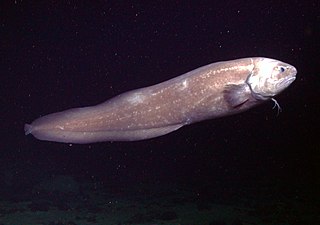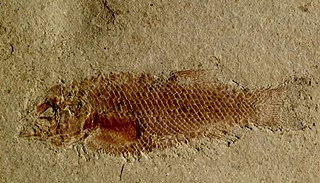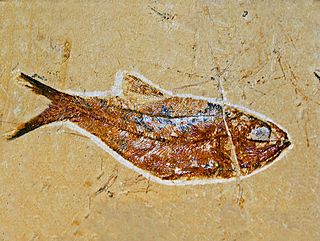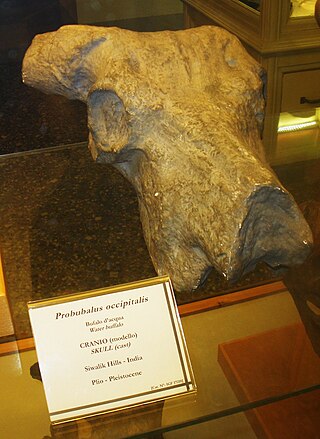
The beardfishes consist of a single extant genus, Polymixia, of deep-sea marine ray-finned fish named for their pair of long hyoid barbels. They are classified in their own order Polymixiiformes. But as Nelson says, "few groups have been shifted back and forth as frequently as this one, and they were recently added to Paracanthoptergii". For instance, they have previously been classified as belonging to the Beryciformes, and are presently considered either paracanthopterygians or the sister group to acanthopterygians. They are of little economic importance.

The cusk-eel family, Ophidiidae, is a group of marine bony fishes in the Ophidiiformes order. The scientific name is from the Greek ophis meaning "snake", and refers to their eel-like appearance. True eels diverged from other ray-finned fish during the Jurassic, while cusk-eels are part of the Percomorpha clade, along with tuna, perch, seahorses and others.
The deep-sea smelts are any members of the family Bathylagidae, a distinct group of marine smelts.

Apateodus is a genus of prehistoric marine ray-finned fish which was described by Woodward in 1901. It was a relative of modern lizardfish and lancetfish in the order Aulopiformes, and one of a number of prominent nektonic aulopiforms of Cretaceous marine ecosystems.
Cryptoberyx is an extinct genus of prehistoric marine ray-finned fish that lived during the late Cenomanian stage of the Late Cretaceous. Two species are known from southern Europe and the Middle East, both part of the former Tethys Sea.

Acentrophorus is an extinct genus of prehistoric freshwater and marine ray-finned fish from the Roadian to the Wuchiapingian of England, Germany (Kupferschiefer), Italy and Russia. There may also be a Triassic occurrence in Australia.
Ampheristus is an extinct genus of prehistoric marine ray-finned fish. It was a basal or stem member of the family Ophidiidae, which contains modern cusk-eels. Fossils are known from worldwide from the Late Cretaceous to the late Paleogene, making it a rather successful survivor of the Cretaceous-Paleogene extinction event.

Colobodus is an extinct genus of marine Triassic ray-finned fish of the family Colobodontidae and order Perleidiformes. Fossils have been found in Europe and China, encompassing the former Tethys Ocean. It could reach body lengths of about 70 cm.
Clupavus is an extinct genus of marine ray-finned fish that lived during the middle of the Cretaceous period. It is known from North Africa, Europe, Brazil, and possibly North America.

The Argentiniformes is an order of marine ray-finned fish whose distinctness was recognized only fairly recently. In former times, they were included in the Osmeriformes as suborder Argentinoidei. That term refers only to the suborder of marine smelts and barreleyes in the classification used here, with the slickheads and allies being the Alepocephaloidei. These suborders were treated as superfamilies Argentinoidea and Alepocephaloidea, respectively, when the present group was still included in the Osmeriformes.
Glossanodon is a genus of fishes in the family Argentinidae.
Plesiocetus is a genus of extinct rorquals found worldwide. It has had a chequered taxonomic history, having served as a wastebasket genus for a handful of mysticete species.
Austriadraco is a genus of pterosaur living during the Late Triassic in the area of present Austria. Its only species—Austriadraco dallavecchiai—was previously attributed to Eudimorphodon, and its closest relatives may have been Eudimorphodon or Arcticodactylus.

Armigatus is an extinct genus of marine clupeomorph fishes belonging to the order Ellimmichthyiformes. These fishes lived in the Cretaceous ; their fossil remains have been found in Mexico, Europe, the Middle East and North Africa, suggesting the genus ranged across the Tethys Sea.

Hemibos is an extinct even-toed ungulate, belonging to the family Bovidae. Its fossil remains were found across Asia and Europe, including findings from China, the Italian Peninsula, the Iberian Peninsula, the State of Palestine, Israel, Pakistan, and India.
The Besano Formation is a geological formation in the southern Alps of northwestern Italy and southern Switzerland. This formation, a thin but fossiliferous succession of dolomite and black shale, is famous for its preservation of Middle Triassic (Anisian–Ladinian) marine life including fish and aquatic reptiles. It is exposed in the Monte San Giorgio and Besano area. It is among the formations responsible for the area being designated as a UNESCO World Heritage Site. In Switzerland, it is also known as the Grenzbitumenzone. The Anisian-Ladinian boundary lies in the upper part of the Besano Formation.
This list of fossil fish research presented in 2021 is a list of new taxa of jawless vertebrates, placoderms, acanthodians, fossil cartilaginous fishes, bony fishes, and other fishes that were described during the year, as well as other significant discoveries and events related to paleoichthyology that occurred in 2021.

The Jaisalmer Formation is a Middle to Late Jurassic-aged geologic formation located in India near the city of Jaisalmer that consists mainly of marine deposits. The formation was first identified and defined by geologist Richard Dixon Oldham in 1886.

Tharosaurus is an extinct genus of dicraeosaurid sauropod dinosaur from the Middle Jurassic Jaisalmer Formation of India. The genus contains a single species, T. indicus, known from several vertebrae and a rib. Tharosaurus represents the earliest diplodocoid currently known and the first described from India.
The Hesseltal Formation or Blackcoloured Formation is a Late Cretaceous geological formation from northern Germany. It consists of lithified marls and limestone, with a unique series of black shales deposited in anoxic conditions during the Cenomanian-Turonian boundary event.










